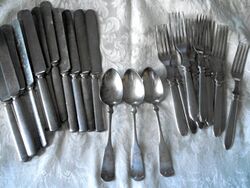
Family heirlooms are an integral part of a family's history and represent more than just objects: they embody tradition, cultural heritage, storytelling, as well as a family's legacy.[1]
Almost anything can be a family heirloom since its definition depends on the family members who assign it some significance or value. And the items do not have to be tactile; it could be a digital recording of an ancestor singing a song or giving a toast at a wedding.
Usually there is a close tie between a family heirloom and a family's history. Most heirlooms are many years old or go back generations. However, an object can be designated as a family heirloom at any time especially when an individual wants to start a new family tradition.
Types of family heirlooms
Most family heirlooms are easily recognizable since they've been passed down for generations. Some may be stored with a note explaining how they became important to the family. However, older items may have no background information and will require some researching to determine if they truly are heirlooms.
- Jewelry including rings, necklaces, brooches, etc. Remember that jewelry styles change over time, so what looks simple and functional may have been decorative and ornamental years ago.
- Furniture including tables, chairs, dressers, etc. Look underneath drawers and tables for labels or notes.
- Textiles including quilts, tapestries, clothing, etc.
- Documents including letters, diaries, telegrams, newspaper articles, journals, certificates, etc.
- Family photographs and albums, scrapbooks, etc.
- Miscellaneous items including tools, kitchenware, toys, etc.
Why family heirlooms are important for genealogy research
Family heirlooms function as tangible connections to a family's past. They illustrate family stories and traditions.
- Heirlooms serve as a window into a time gone by. For younger generations they make history real and believable.
- Tracing the provenance and ownership of heirlooms can add to an ancestor's genealogical information and actually prove various data points such as occupations, business ownership, craft making and hobbies, as well as lifestyles.
- Heirlooms can emphasize a family's culture and traditions. They can help explain certain religious and holiday practices.
Family heirloom preservation
Depending upon the age and type of heirloom, consider taking preservation measures to ensure that the item remains intact for future generations.
- Remember the motto of archivists: do no harm! This means do not write on or mark up items. Do not laminate or use permanent preservation methods. Follow sound archival preservation practices including use of acid-free boxes and envelopes. Test any cleaning method on a small section of the item before using. Consider handling items with cotton archival gloves to minimize contact with oils and chemicals on hands and fingers.
- Some items may need conservation and restoration. Seek out trusted professionals to do this type of work.
The stories behind family heirlooms
The stories attached to family heirlooms can only be passed down to future generations if they are first documented in a fixed format.
- Document the family story about the heirloom that has been passed down for generations and place it in fixed format. This means in writing, or take a photograph, or create an audio recording of the story.
- Also research the history of the heirloom including possible dates, materials, and more.
- Add related genealogical research to the story including previous owners and the provenance, or chain of possession.
Sharing family heirlooms
Once family heirlooms have been identified, preserved, and documented, then sharing them with friends and family becomes possible.
- Display items in the home or office. Consider adding a display card with information about the heirloom, or better yet, include a QR code so the digital version of the item can be viewed.
- Use an heirloom during story telling time with family members.
- Consider loaning items to a local public library, historical society, or museum.
- Gift heirlooms to future generations, entrusting them to carry on the family tradition and stories.
- Include heirlooms in estate planning papers and designate the individual(s) inheriting the items.
- Don't forget to create a digital copy of a family heirloom. Include photos, the story behind the item, any genealogy research related to the heirloom, as well as audio and video.
Other issues
- For items that depict or relate to living family members, secure their permission before displaying the family heirlooms.
- For valuable items, make sure items are secure before being displayed and consider insuring the items in case of damage or theft.
See also
Explore more about family heirlooms
- Caring for Keepsakes: The Top 10 Family Heirlooms (BONUS webinar for subscribers) at Legacy Family Tree Webinars
- DNA Testing of Artifacts and Family Heirlooms? webinar at Legacy Family Tree Webinars
References
- ↑ 15 Common Family Heirlooms You May Find in Your Home. LoveToKnow.com